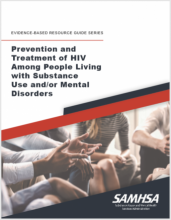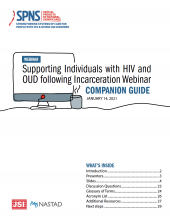
This document describes the critical role that peers have in developing and delivering care for people with HIV and OUD and how a state’s Medicaid program can serve as an essential fiscal resource in supporting peer services.



This document describes the critical role that peers have in developing and delivering care for people with HIV and OUD and how a state’s Medicaid program can serve as an essential fiscal resource in supporting peer services.
This package is a learning tool designed for health departments and community-based organizations newly offering syringe services programs (SSPs) with the purpose of indexing the materials needed for safer injection, what to offer at a syringe services program, and how to explain what materials a
This webinar companion guide offers attendees a resource to supplement the information covered during a webinar and extend the webinar’s benefits beyond the allotted presentation time. It contains:
A recent study published in Drug and Alcohol Dependence found evidence for racial/ethnic disparities in buprenorphine distribution across the United States.
Transgender people and communities, including nonbinary people, have specific needs within harm reduction programs.
This report analyzes the issues and trends underlying the syndemics of HIV, SUD, and viral hepatitis in West Virginia.
This document provides a quick overview of the federal discretionary funding programs that support essential aspects of the nation’s HIV response.
In recent years, the gap in the rate of opioid overdoses among Black and white Americans has narrowed significantly, with increases in Black mortality driven in part by the addition of synthetic opioids to other drugs.
Achieving the goals of the Ending the HIV Epidemic (EHE) Initiative depends on doing more to strengthen communities, reduce the harm associated with drug use, and prevent disease transmission.